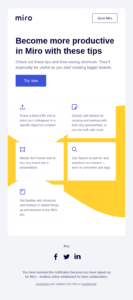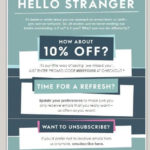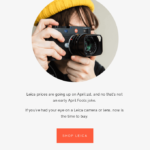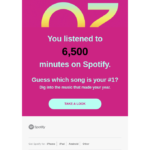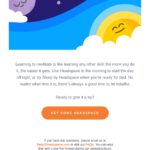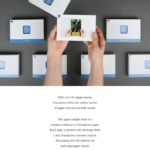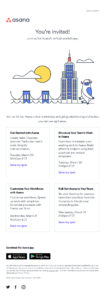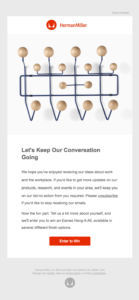10 Best Re-Engagement Email Campaigns Examples
Emails are marketing 101—we all know that. But after sending (and receiving) what feels like billions of emails yourself, you’re probably wondering how to set your business apart.
You’re facing a lot of competition for your customer’s attention, countless promotions, Google’s filters, and so much more.
It’s no secret that crafting an engaging email can be a huge driver for customer engagement and sales. It’s also one of the reasons why re-engagement email campaigns can produce even more value for your business.
Are you worried your thoughtfully-curated emails aren’t being seen? There’s a good chance that fear is based in reality. Hubspot revealed that email list decay costs businesses around 22.5% of their subscribers each year.
So, what can you do to create re-engagement email campaigns that convert? Take a look at these—the best re-engagement email campaigns—for punchy, effective, and engaging email examples to draw some much-needed inspiration for your next campaign.
10 of The Best Re-engagement Email Examples for 2022
1. The Standard Reminder Email
Some of the best reactivation emails are those that simply remind the customer of what your product is or does. The products you offer satisfy a need they have already had and chances are they need it again!
Life does get busy, and there’s no way to know when could be the perfect time to pop up in someone’s inbox and give them a chance to browse and become re-introduced to everything you have to offer.
2. The We Miss You Email
The we miss you email is a classic example any brand can use to remind past customers not only of a brand’s existence, but its value too.
While an adorable puppy might be the reason eyes linger on the page, it likely isn’t enough to translate into a sale for a new customer. However, the beauty of re-engagement emails is leveraging the pre-established knowledge customers have of your brand (combined with promo codes to boost sales), which is all some shoppers need to jump-start their memory and start clicking around.
3. The Funny Email
The funny email is all about charming previous customers with hilarious copy, pictures, and other design elements.
Using humor can be a way for consumers to see behind the brand to the people who make it thrive. This approach helps breakaway from the standard plea for more business to something more human, and frankly, more entertaining.
4. The Enticing Email
Urgency is one of the most powerful tools email marketers have at their disposal. The enticing email focuses on sharing deals your customers cannot pass up.
If there are rarely sales or discounts, a great way to encourage shoppers to peruse new additions is by offering a deal they simply can’t refuse.
These emails should focus on promotion expiry dates, limited quantities, and other elements that highlight the importance of acting now.
5. The Above and Beyond Email
This personalized message is more than just sweet, it’s smart and focuses on creating an exceptional experience for your customers.
Many businesses go beyond the call of duty when it comes to knowing their customer base. Your local bagel place may already know your name. They also know how you take your coffee, your dog’s name, and your birthday. Most small and mid-sized businesses are familiar with you on a personal level.
The above and beyond email is all about showing your customers you love and appreciate their business. It focuses on the little details to create a highly personalized experience.
6. The Simple Email
Sometimes, less is more. The simple email focuses on a more direct approach, showing your customers you value their time. It’s a great way to highlight new product releases, marketing initiatives, or small updates.
Personalized touches are essential to good business, but driving web-traffic doesn’t have to mean lengthy paragraphs written to each of your customers. Some of the best customer engagement campaigns are composed of two or three well written lines.
Centering a message around what you offer and why they should come back is often enough to re-engage email subscribers—after all, they’ve already purchased from you at least once.
Keeping returning customers isn’t just nice, it’s critical. Research shows that the success rate when remarketing to past customers is around 60-70% and only 5-20% for new customers.
7. The Authentic Email
A simple email message that speaks clearly to who you are is huge and doesn’t have to be lengthy.
Be true to your brand and the message you want to share. If you are a solely owned and operated small business, flashy long emails to compete with big box stores may not be the way to go. Whatever your brand is, allow it to be at the heart of these kinds of emails.
Focus on your values, the fact that your products are eco-friendly or 100% American-made. The goal is to create an authentic connection with your customers, so you can improve brand loyalty and awareness.
8. The Invite Email (Pre and Post Event)
Here’s the deal. Everyone likes to be invited to things. The invite email keeps your customers in the know.
Remind customers why they opted into your email list by showcasing unique opportunities, events, and other must-read content. People want to know about new products and offerings in an engaging way.
For example, if you have a virtual pop-up store event or webinar coming up, it might be a no-brainer to invite past customers to register and attend. However, it’s equally important to reach out and provide a recording to anyone who may have missed the event.
Not only does this keep your customers informed, but it provides you with a great opportunity to market fresh content to additional audiences in your email list.
9. The Cutting Edge Email
Trends change all the time. The cutting edge email aims to highlight how your products and services are staying ahead of new trends.
Think about it like this. Maybe you started selling hand sanitizer during the pandemic. This type of email shows you are relevant and capable of keeping up with current trends.
The world is constantly changing, and with that change comes new opportunities to fix customers’ pain points. Did your product line expand? Is there a limited-edition version of a best-seller available? Let them know.
10. The Love Letter Email
Sometimes you need to persuade your customers to give you one more short.
Losing sales feels worse than a breakup. One of the easiest ways to save a lost sales is to ask them to come back in a lighthearted way.
Expressing your appreciation for customers is always a good idea and this is just another way to let them know you’re thinking of them.
If a long-term customer that used to order consistently has taken a break, initiating a conversation about feedback is great for competitive analysis and an easy way to strike up a genuine conversation with a person who loves and wants to help you improve your products and services.
Re-Engagement Emails: A Must-Have In Any Successful Email Marketing Strategy
A re-engagement email goes far beyond the normal reach of a traditional email campaign. Leveraging existing customers to reintroduce your business with a fresh flare is a great way to drum up sales and meet evolving customer needs.
Regardless of what email template you choose, here are some easy things you can incorporate in every single one:
- Be a straight shooter: A unique email sets you apart and entertains the reader but they should still know exactly what you’re offering. If it’s a new product release, there is no reason for you to give your life’s story.
- Short and sweet: The longer the email, the less likely it’s read all the way through. Keep it simple!
- Be on brand: The fact that this messaging is aimed at a returning customer should be at the top of your mind. They have made purchases from you before because they like the products and feel of the company.
- Consistency is key: Stay consistent with your email messaging so they’re reminded of how much they already like what you have to offer.
- Encourage connection: Make it easy for the reader to contact the business so they can feel in-touch with customer service and feel their value.
Are you looking to develop a re-engagement email campaign? Transform your email marketing strategy with ActiveTrail’s powerful email campaign software. Book a discovery call today to get started.
Reactivation Email Examples: The Power of Rekindling Customer Relationships
Reactivation email examples are a powerful tool in the marketer’s arsenal. These emails are designed to re-engage customers who have become inactive or unresponsive. They serve as a reminder of the value your product or service provides and often offer incentives to encourage customers to interact with your brand again. The best reactivation emails are personalized, relevant, and timely, addressing the customer’s needs and interests directly. They can be a simple reminder of your product’s benefits, a special offer, or even a heartfelt message expressing how much you miss their business.
Reactivation email campaign examples can range from a simple “We Miss You” email to more complex campaigns that include a series of emails. For instance, a B2B re-engagement email might start with a personalized message acknowledging the lapse in communication, followed by emails highlighting new product features, customer testimonials, or industry trends that the customer might find interesting. The goal is to remind the customer of the value your business provides and encourage them to re-engage with your brand.
Customer Engagement Email Examples: Building Stronger Relationships
Customer engagement email examples are all about building and maintaining strong relationships with your customers. These emails are designed to keep your customers interested and engaged with your brand, even when they’re not actively making a purchase. They can include updates about your business, information about new products or services, or helpful content related to your industry.
The best customer engagement email examples provide value to the customer. This could be educational content, exclusive offers, or personalized recommendations based on the customer’s past purchases or browsing behavior. For instance, a customer re-engagement email might include a special offer for a product the customer has shown interest in the past. The key is to make the customer feel valued and appreciated, which can lead to increased loyalty and repeat business.
FAQ Section
How do you write a re-engagement email?
Writing a re-engagement email involves understanding your audience, personalizing your message, and providing value. Start by acknowledging the lapse in communication or activity, then highlight what’s new with your brand or offer an incentive to encourage re-engagement. Keep your message concise, clear, and focused on the customer’s needs and interests.
What is a reactivation email?
A reactivation email is sent to customers who have become inactive or unresponsive over time. The goal of these emails is to re-engage these customers and encourage them to interact with your brand again. This can be done by reminding them of the value your product or service provides, offering special incentives, or providing helpful and relevant content.
What is an email to reengage a customer?
An email to reengage a customer is a personalized message designed to reignite the customer’s interest in your brand. It can include updates about your business, information about new products or services, special offers, or helpful content. The goal is to remind the customer of the value your brand provides and encourage them to interact with your brand again.
How do I reengage a cold email list?
Reengaging a cold email list involves sending targeted, personalized emails to subscribers who have not interacted with your brand in a while. Before launching your re-engagement campaign, it’s crucial to validate the email addresses on your list to ensure high deliverability and to maintain a clean email list. Start by segmenting your list based on activity level, then craft a re-engagement campaign that provides value and encourages interaction. This could involve a special offer, a request for feedback, or a helpful piece of content.
Read more:
Email Marketing Metrics 101: What You Should Be Monitoring

